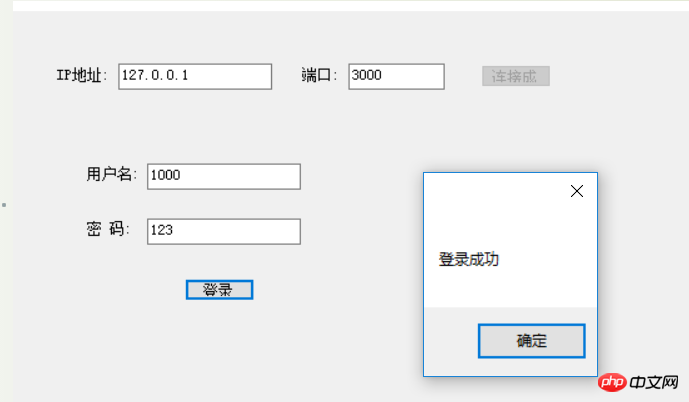這篇文章主要介紹了C# networkcomms 3.0實現模擬登陸總結,需要的朋友可以參考下
最近專案需要做一個客戶查詢狀態系統,當前上位機缺少服務功能,於是找到了networkcomms 開源框架,作為專案使用.
最新版networkcomms 下載位址:https://github.com/MarcFletcher/NetworkComms.Net
下載直接vs開啟
新伺服器端

#
1 2 3 4 5 6 7 8 9 10 11 12 13 14 15 16 17 18 19 20 21 22 23 24 25 26 27 28 29 30 31 32 33 34 35 36 37 38 39 40 41 42 43 44 45 46 47 48 49 50 51 52 53 54 55 56 57 58 59 60 61 62 63 64 65 66 67 68 69 70 71 72 73 74 75 76 | using MessageContract;
using NetworkCommsDotNet;
using NetworkCommsDotNet.Connections;
using NetworkCommsDotNet.Connections.TCP;
using NetworkCommsDotNet.DPSBase;
using System;
using System.Collections.Generic;
using System.ComponentModel;
using System.Data;
using System.Drawing;
using System.Linq;
using System.Net;
using System.Text;
using System.Windows.Forms;
namespace AppServer
{
public partial class MaiForm : Form
{
public MaiForm()
{
InitializeComponent();
}
SendReceiveOptions aboveOptions = new SendReceiveOptions(DPSManager.GetDataSerializer<ProtobufSerializer>(), null, null);
private void button1_Click(object sender, EventArgs e)
{
Connection.StartListening(ConnectionType.TCP, new IPEndPoint(IPAddress.Parse(txtIP.Text), int.Parse(txtPort.Text)));
button1.Text = "监听中";
button1.Enabled = false;
StartListening();
}
private void StartListening()
{
NetworkComms.DisableLogging();
NetworkComms.AppendGlobalIncomingPacketHandler<LoginContract>("ReqLogin", IncomingLoginRequest);
}
private void IncomingLoginRequest(PacketHeader header, Connection connection, LoginContract loginContract)
{
try
{
string resMsg = "";
if (loginContract.UserID == "1000" && loginContract.PassWord == "123")
resMsg = "登录成功";
else
resMsg = "用户名密码错误";
ResMsgContract contract = new ResMsgContract();
contract.Message = resMsg;
connection.SendObject("ResLogin", contract);
}
catch (Exception ex)
{
}
}
}
}
|
登入後複製
在別的幫助中往往少了這行:導致出現客戶端發送時,類型打包出現問題. 這行程式碼是客戶端伺服器兩端都要加上的,是指定傳輸方式
1 | SendReceiveOptions aboveOptions = new SendReceiveOptions(DPSManager.GetDataSerializer<ProtobufSerializer>(), null, null);
|
登入後複製
就是這個報錯了

一下是客戶端

1 2 3 4 5 6 7 8 9 10 11 12 13 14 15 16 17 18 19 20 21 22 23 24 25 26 27 28 29 30 31 32 33 34 35 36 37 38 39 40 41 42 43 44 45 46 47 48 49 50 51 52 53 54 55 56 | using MessageContract;
using NetworkCommsDotNet;
using NetworkCommsDotNet.Connections;
using NetworkCommsDotNet.Connections.TCP;
using NetworkCommsDotNet.DPSBase;
using System;
using System.Collections.Generic;
using System.ComponentModel;
using System.Data;
using System.Drawing;
using System.Linq;
using System.Text;
using System.Windows.Forms;
namespace AppClient
{
public partial class MainForm : Form
{
public MainForm()
{
InitializeComponent();
}
public ConnectionInfo connInfo = null;
Connection newTcpConnection;
SendReceiveOptions aboveOptions = new SendReceiveOptions(DPSManager.GetDataSerializer<ProtobufSerializer>(), null, null);
private void button1_Click(object sender, EventArgs e)
{
connInfo = new ConnectionInfo(txtIP.Text, int.Parse(txtPort.Text));
newTcpConnection = TCPConnection.GetConnection(connInfo);
button1.Enabled = false;
button1.Text = "连接成功";
}
private void btnlogin_Click(object sender, EventArgs e)
{
LoginContract contract = new LoginContract(txtUserName.Text, txtPassword.Text);
ResMsgContract resMsg = newTcpConnection.SendReceiveObject<logincontract, resmsgcontract="">("ReqLogin", "ResLogin", 5000, contract);
if (resMsg.Message == "登录成功")
{
MessageBox.Show("登录成功");
}
else
{
MessageBox.Show("用户名密码错误");
}
}
}
}</resmsgcontract></logincontract,>
|
登入後複製
契約類別
1 2 3 4 5 6 7 8 9 10 11 12 13 14 15 16 17 18 19 20 21 22 23 24 25 26 27 28 29 30 31 32 33 34 35 36 37 38 39 40 | using System;
using System.Collections.Generic;
using System.Linq;
using System.Text;
namespace MessageContract
{
[ProtoContract]
public class LoginContract
{
[ProtoMember(1)]
public string UserID { get; set; }
[ProtoMember(2)]
public string PassWord { get; set; }
public LoginContract() { }
public LoginContract(string userID, string passWord)
{
this.UserID = userID;
this.PassWord = passWord;
}
}
}
using ProtoBuf;
using System;
using System.Collections.Generic;
using System.Linq;
using System.Text;
namespace MessageContract
{
[ProtoContract]
public class ResMsgContract
{
[ProtoMember(1)]
public string Message;
public ResMsgContract() { }
public ResMsgContract(string message)
{
this.Message = message;
}
}
}
|
登入後複製
注意:
使用這個框架要配合Google的protobuf 要選好版本.本人沒重複測試最高版本,因為在調試登入過程中出現別的問題過程中,也順改了protobuf 的版本,至今未測試最高版本是否存在兼容問題.本人成功的使用的是2.0.0.668
protobuf簡介protobuf是google提供的一個開源序列化框架,類似於XML,JSON這樣的資料表示語言,其最大的特點是基於二進位,因此比傳統的XML表示高效短小
#vs nuget新增方式

輸入

#版本選擇自己指定一下,加大專案的契約類裡邊.這是自己定義傳輸物件的方式.

結果:

以上所述是小編給大家介紹的C# networkcomms 3.0實現模擬登陸總結,希望對大家有幫助,如果大家有任何疑問請給我留言,小編會及時回覆大家的。在此也非常感謝大家對腳本之家網站的支持!
以上是C#中networkcomms3.0如何實現模擬登陸的程式碼分享(圖)的詳細內容。更多資訊請關注PHP中文網其他相關文章!











